Made with glutinous rice and red bean paste, these Japanese Sweet Rice Balls are offered to one’s ancestors and eaten during the spring and autumn equinoxes in Japan. They are called Botamochi in spring and Ohagi in autumn.
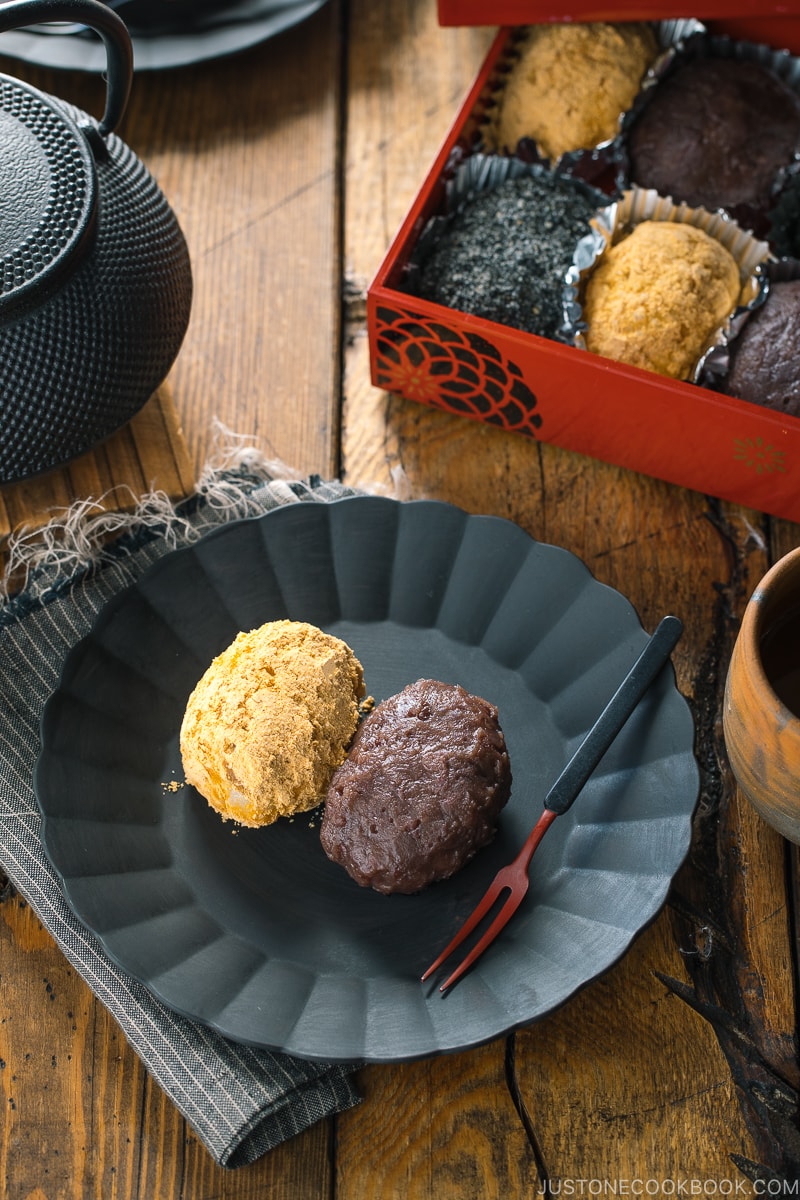
Growing up in Japan, I remember we had a lot of cultural, seasonal, and sometimes religious celebrations that often come with specific foods.
Ohagi or Botamochi is one of those special foods we enjoyed during spring and autumn equinoxes every year. They are sweet rice balls filled or coated with red bean paste. Today, I’ll share little cultural tidbits of this traditional sweet along with the recipe!
What is Ohagi (Botamochi)?
These sweet rice balls are usually made with glutinous rice, sometimes rice, and red bean paste.
The rice balls are formed into the shape of a small cylinder and covered with red bean paste on the outside. There are also variations where the rice balls are coated with sweetened soybean flour or sweetened ground black sesame and stuffed with red bean paste on the inside.
They are commonly eaten during Ohigan (お彼岸), a Buddhist holiday during both spring and autumn equinoxes.
Botamochi vs. Ohagi
You’ve probably noticed that I keep calling these sweet rice balls with two names – Ohagi and Botamochi. That’s because we call these rice balls differently in spring and autumn.
In spring, they are called Botamochi (ぼたもち), named after the spring flower, botan (牡丹 peony).
In autumn, they are called Ohagi (おはぎ), named after the autumn flower, hagi (萩 bush clover).
Regionally, people may grow up calling it just by one name, but they are essentially the name.
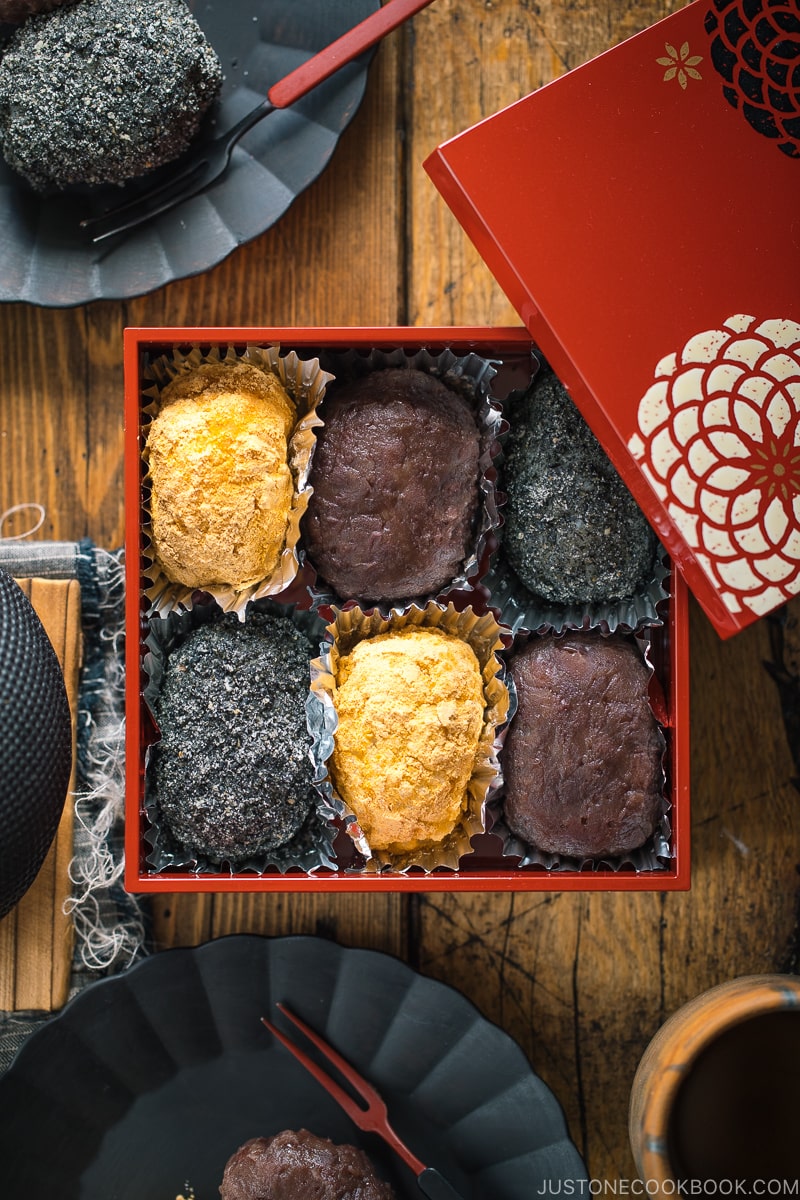

How to Make Ohagi (Botamochi)
Unlike some mochi recipes on my blog that require hard-to-find rice flour, this Ohagi (Botamochi) recipe is rather simple. All you need is Japanese glutinous rice (please, use a short-grain variety), Japanese short-grain rice, and red bean paste. Here are the 3 steps to make these rice balls:
- Cook glutinous rice and rice – Cook glutinous rice and rice together in the rice cooker (or whatever you use to cook rice).
- Pound the rice – Partially pound the cooked rice.
- Shape and fill the rice balls – Shape the pounded rice into balls and coat them with red bean paste. For the other two variations, fill the rice balls with sweet red bean paste and coat them with either sweetened soybean flour (kinako) or sweetened ground black sesame seeds.
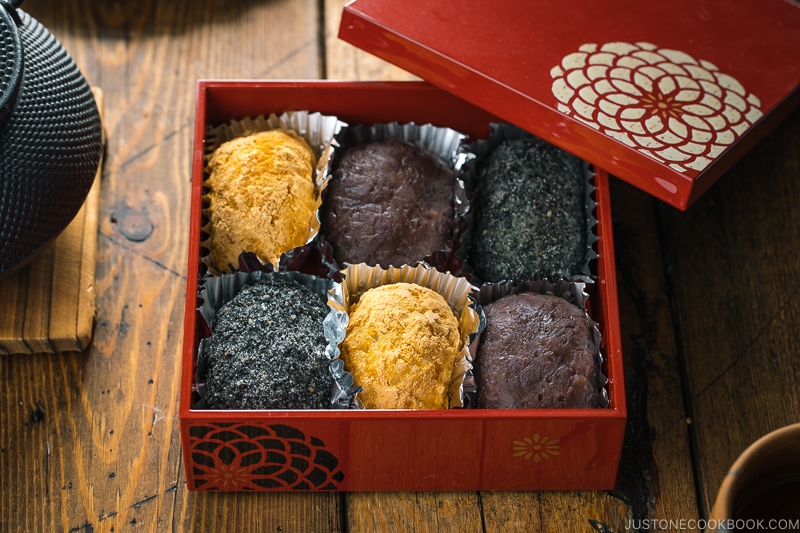

5 Tips to Make Ohagi (Botamochi)
1. Combine Glutinous Rice and Rice
Ohagi (Botacmochi) are often made with only glutinous rice (sweet rice). However, I do not recommend using just glutinous rice as these sweet rice balls get cold or less “fresh”, the texture will become hard and not so chewy.
Mixing it with regular rice helps to keep the texture softer and chewier.
2. Pre-measure Anko (Red Bean Paste)
Once the cooked rice is pounded, it’s best to shape it while the rice is still warm. If you pre-measure the paste and roll it into balls ahead of time, you can just grab the paste and stuff in the rice balls quickly.
3. Partially Pound the Rice
One of the unique features of Ohagi (Botamochi) is the noticeable rice texture when you bite into it. Unlike other similar mochi sweets where fine rice flours are used, the rice is pounded partially, not mashed or kneaded all the way. This half-pounding technique is called “Hangoroshi“, literary a half kill (半殺し).
4. Use Plastic Wrap to Thinly Spread the Red Bean Paste
Plastic wrap helps tremendously when you need to spread a thin layer of red bean paste around the rice balls. I’ve tried using my bare hand instead of plastic wrap, but I think you need a lot of practices to make it look presentable.
5. Save and Reapply Black Sesame and Soybean Flour
Within 10-15 minutes after you coat the rice balls with black sesame seeds and soybean flour, you will notice the color of those Ohagi (Botamochi) get darker and spotty.
This happens because the moisture in the rice is released to the coating. Therefore, it’s best to keep some coating and reapply it right before serving.
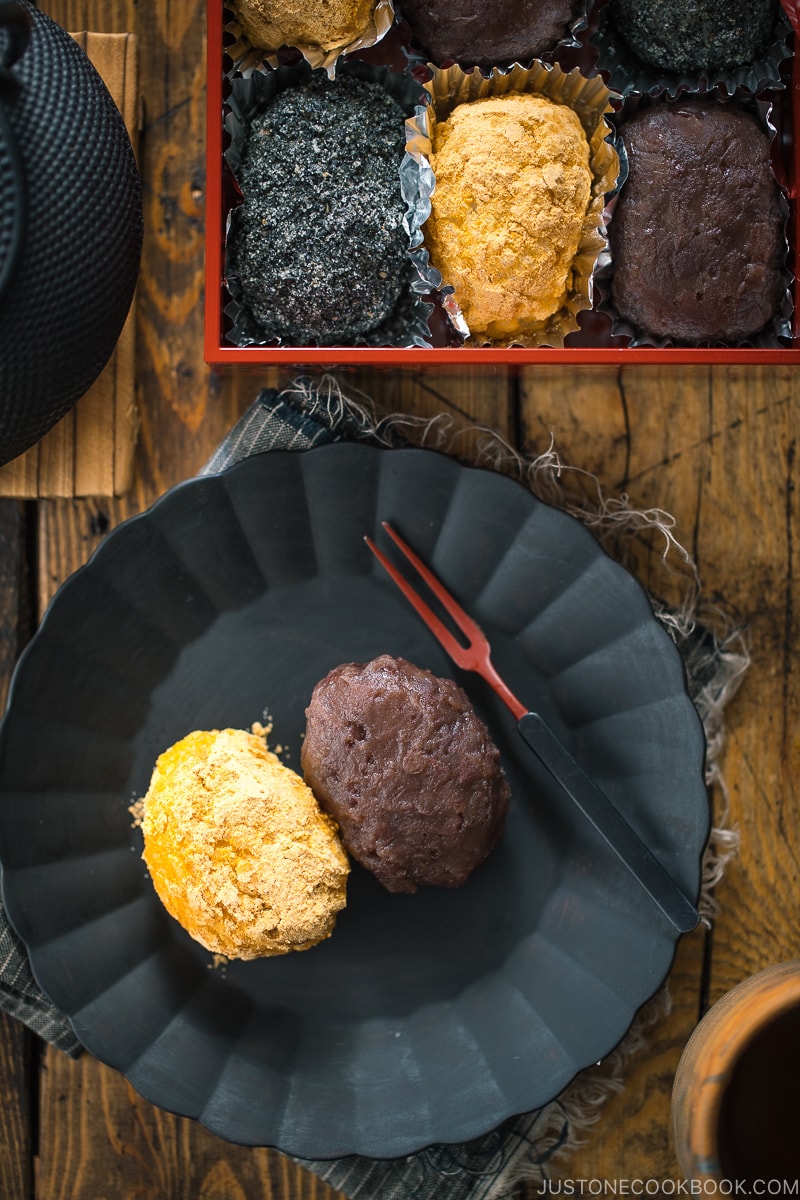

How to Store and Enjoy Ohagi
As they are made of both glutinous rice and rice, Ohagi is not suitable to store in the refrigerator. The temperature will only turn the rice balls hard and lose the soft, chewy texture. Therefore, it’s best to keep them in a cool place and enjoy them as soon as possible (half-day to 12 hours).
March might be cool, but September can still be warm and the food may go bad faster. In that case, I recommend storing them in the refrigerator but cover the container with a thick towel to protect from cold air. They should be kept cool, ideally.
You can also freeze Ohagi for up to 1 month. When you’re ready to eat, defrost overnight in the refrigerator.
To bring back the ideal texture, Ohagi should be reheated gently in the microwave to warm or room temperature for you to enjoy.
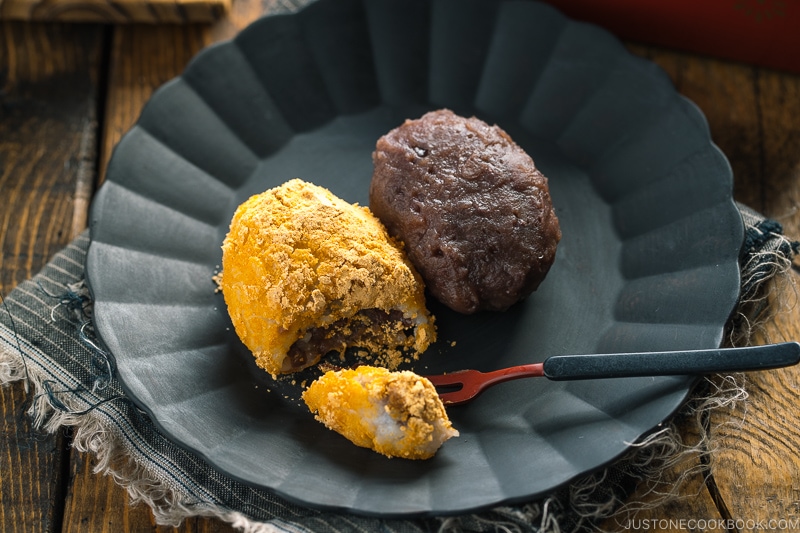

Ohagi (Botamochi) are not so sweet and they go well with green tea. Even though I don’t observe the religious ceremony, I still make these for my family twice a year around the spring and autumn equinox. In my house, food culture is pretty important and I hope my children will remember my sweet Japanese rice balls twice a year.
Other Seasonal Japanese Sweets
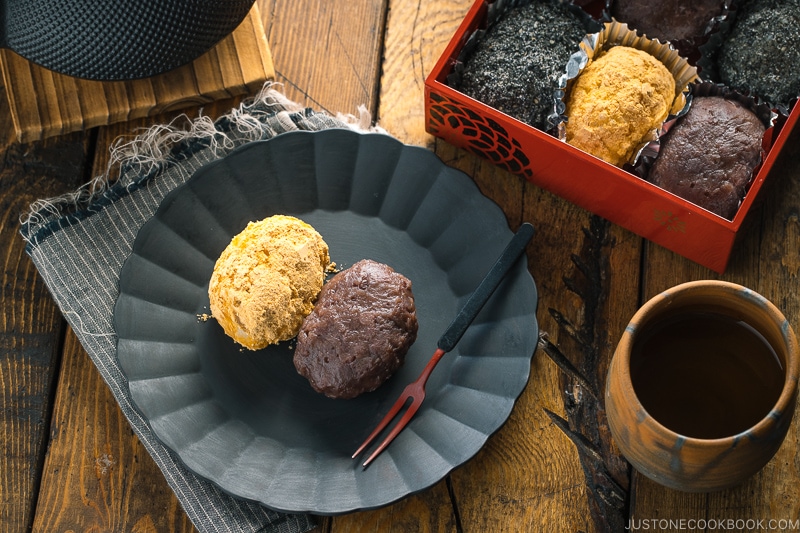

Wish to learn more about Japanese cooking? Sign up for our free newsletter to receive cooking tips & recipe updates! And stay in touch with me on Facebook, Pinterest, YouTube, and Instagram.
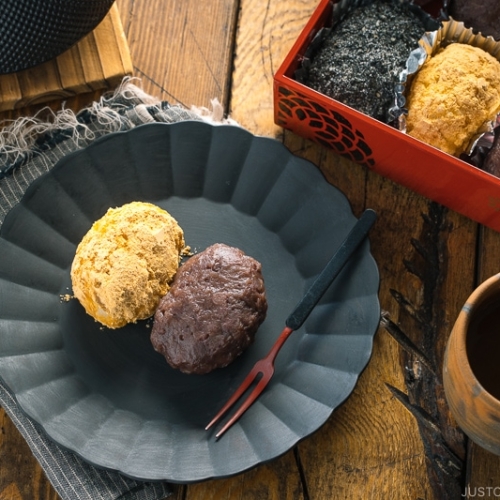

Ohagi (Botamochi)
Made with glutinous rice and red bean paste, these Japanese Sweet Rice Balls are offered to one’s ancestors and eaten during the spring and autumn equinoxes in Japan. They are called Botamochi in spring and Ohagi in autumn.
Servings: 24 pieces (roughly 24-26)
Ingredients
For the Black Sesame Coating
For the Soybean Flour Coating
For the Red Bean Paste Filling and Coating
Prevent your screen from going dark
Instructions
To Prepare the Glutinous Rice
To Prepare the Coatings and Filling
To Make with Anko Filling
To Make with Anko Coating
To Store
-
It’s best to keep them in a cool place and enjoy them as soon as possible (within a half day or 12 hours). If it’s too warm to keep at room temperature, I recommend storing them in the refrigerator, but cover the container with a thick towel to protect the from cold air. Ideally, they should be kept cool. You can also freeze Ohagi for up to 1 month. When you’re ready to eat, defrost overnight in the refrigerator. To bring them back an ideal texture, Ohagi should be reheated gently in the microwave until warm or at room temperature for you to enjoy.
Nutrition
Nutrition Facts
Ohagi (Botamochi)
Amount per Serving
% Daily Value*
* Percent Daily Values are based on a 2000 calorie diet.
Editor’s Note: This post was originally published on March 16, 2020. It was republished on March 11, 2024.

